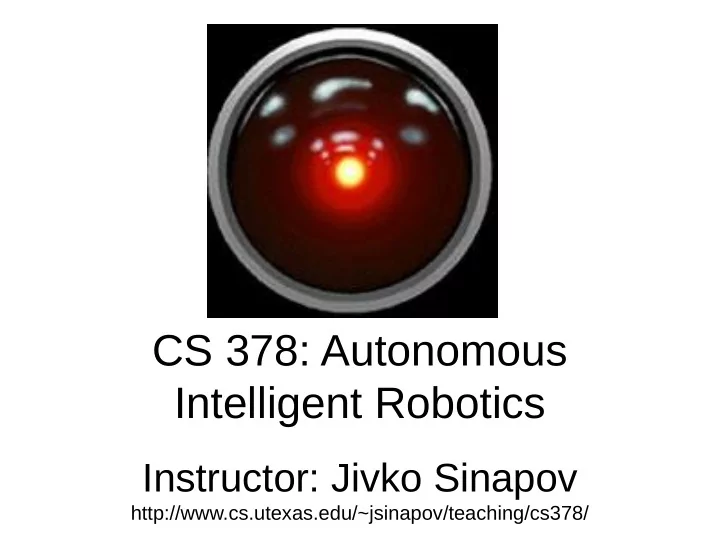

CS 378: Autonomous Intelligent Robotics Instructor: Jivko Sinapov http://www.cs.utexas.edu/~jsinapov/teaching/cs378/
Audio Processing and Computational Perception of Natural Sound
Why Sound?
Why Sound? What actually happened: The robot dropped a soda-can
Why Natural Sound is Important “…natural sound is as essential as visual information because sound tells us about things that we can't see , and it does so while our eyes are occupied elsewhere. “ “Sounds are generated when materials interact, and the sounds tell us whether they are hitting, sliding, breaking, tearing, crumbling, or bouncing . “ “Moreover, sounds differ according to the characteristics of the objects , according to their size, solidity, mass, tension, and material. “ Don Norman, “ The Design of Everyday Things ”, p.103
Why Natural Sound is Important Sound Producing Event [Gaver, 1993]
Why should a robot use acoustic information? Human environments are cluttered with objects that generate sounds Help a robot perceive events and objects outside of field of view Help a robot perceive material properties of objects, and form natural object categories
What is Sound?
What is Sound?
What is Sound?
What is Sound? ….from a computer's point of view, raw audio is a sequence of 44.1K floating point numbers arriving each second
Sine Wave [http://www.audiophilejournal.com/what-is-a-hz-or-hertz-in-audio/]
Sine Curve [http://clem.mscd.edu/~talmanl/HTML/SineCurve.html]
Frequency • Measured in Hertz (Hz) • Named after Heinrich Hertz • 1 Hertz = 1 repetition per second • Typically denoted with the letter f
Period • How long does one cycle take? • It is the reciprocal of the frequency • Measured in seconds • Typically denoted with the letter T
Frequency vs Period Animation [http://en.wikipedia.org/wiki/Frequency]
Frequency vs Period
Amplitude (vertical stretch) 3 sin(x) [http://www.sparknotes.com/math/trigonometry/graphs/section4.rhtml]
Frequency (horizontal stretch) [http://www.sparknotes.com/math/trigonometry/graphs/section4.rhtml]
What is the Period and the Amplitude? [http://www.sparknotes.com/math/trigonometry/graphs/problems_3.html]
What is the Period and the Amplitude? [http://www.sparknotes.com/math/trigonometry/graphs/problems_3.html]
Sines vs Cosines [http://en.wikipedia.org/wiki/Sine_wave]
Formula for the Sine Wave
Formula for the Sine Wave • A, the amplitude, is the peak deviation of the function from its center position. • ω, the angular frequency, specifies how many oscillations occur in a unit time interval, in radians per second • φ, the phase, specifies where in its cycle the oscillation begins at t = 0.
A function x(t) is periodic if we can find a T for which the following hold
Sinusoidal waves of various frequencies Low Frequency High Frequency [http://en.wikipedia.org/wiki/Frequency]
Spectrum [http://en.wikipedia.org/wiki/Spectrum]
Light Spectrum [http://en.wikipedia.org/wiki/Frequency]
[http://en.wikipedia.org/wiki/Spectrum_allocation]
Standing Wave (shown in black, equal to the sum of the red and the blue waves traveling in opposite directions) [http://en.wikipedia.org/wiki/Wavelength]
Fourier Series A Fourier series decomposes periodic functions or periodic signals into the sum of a (possibly infinite) set of simple oscillating functions, namely sines and cosines
Approximation [http://en.wikipedia.org/wiki/Fourier_series]
Approximation
Discrete Fourier Transform . . . .
Discrete Fourier Transform
Discrete Fourier Transform Frequency bin Time
Research Question Can the DFT be used by a robot to perceive objects and their properties using sound?
Research Question Can the DFT be used by a robot to perceive objects and their properties using sound? How should the robot associate a particular sound with an object?
Object Exploration by a Robot
Object Exploration by a Robot
Objects [Sinapov, Weimer, and Stoytchev, ICRA 2009]
Behaviors Grasp : Push : Shake : Tap: Drop :
Recognition Video
Audio Feature Extraction Behavior Execution: WAV file recorded: Discrete Fourier Transform:
Audio Feature Extraction 1. Training a self-organizing map (SOM) using DFT column vectors:
Audio Feature Extraction 2. Use SOM to convert DFT spectrogram to a sequence:
Audio Feature Extraction 2. Use SOM to convert DFT spectrogram to a sequence: S i : (3,2) ->
Audio Feature Extraction 2. Use SOM to convert DFT spectrogram to a sequence: S i : (3,2) -> (2,2) ->
Audio Feature Extraction 2. Use SOM to convert DFT spectrogram to a sequence: S i : (3,2) -> (2,2) -> (4,4) -> ….
Audio Feature Extraction 1. Training a self-organizing map 2. Discretization of a DFT of a (SOM) using column vectors: sound using a trained SOM is the sequence of activated SOM nodes over the duration of the sound
Problem Formulation Model predictions: Object Recognition Model Sound S i Sequence: Behavior drop Recognition Model
Recognition Model • k-NN: memory-based learning algorithm With k = 3: 2 neighbors 1 neighbors ? Test point Therefore, Pr(red) = 0.66 Pr(blue) = 0.33
Off-Line Evaluation • 10 trials performed with each of the 36 objects with each of the 5 behaviors • A total of 1800 interactions, about 12 hours • 10 fold cross-validation • Performance Measure for object and behavior recognition:t
Evaluation Results Chance accuracy = 2.7 %
Evaluation Results
Estimating Acoustic Object Similarity using Confusion Matrix : similar Predicted → : similar 40 4 0 0 Actual 6 42 0 0 : different 0 0 21 6 0 0 8 35 : different
Full Confusion Matrix for all 36 objects: t r e v n i ISOMAP Hierarchical Clustering ISOMAP Hierarchical Clustering
(mostly) metal (mostly) metal Balls Balls objects objects Plastic Objects Plastic Objects Objects with Objects with (mostly) wooden (mostly) wooden Paper Objects Paper Objects contents inside contents inside objects objects
Recognizing the sounds of objects manipulated by other agents
Recognizing the sounds of objects manipulated by other agents
Further Reading • Sinapov, J., Wiemer, M., and Stoytchev, A. (2008). Interactive Learning of the Acoustic Properties of Objects by a Robot. In proceedings of the "Robot Manipulation: Intelligence in Human Environments" workshop held at the Robotics Science and System Conference , 2008. • Sinapov, J., Wiemer, M., and Stoytchev, A. (2009). Interactive Learning of the Acoustic Properties of Household Objects. In proceedings of the 2009 IEEE International Conference on Robotics and Automation (ICRA).
Discussion • What kind of sounds should our mobile robots pay attention to? • What would auditory perception allow them to do that they currently cannot?
THE END
Recommend
More recommend